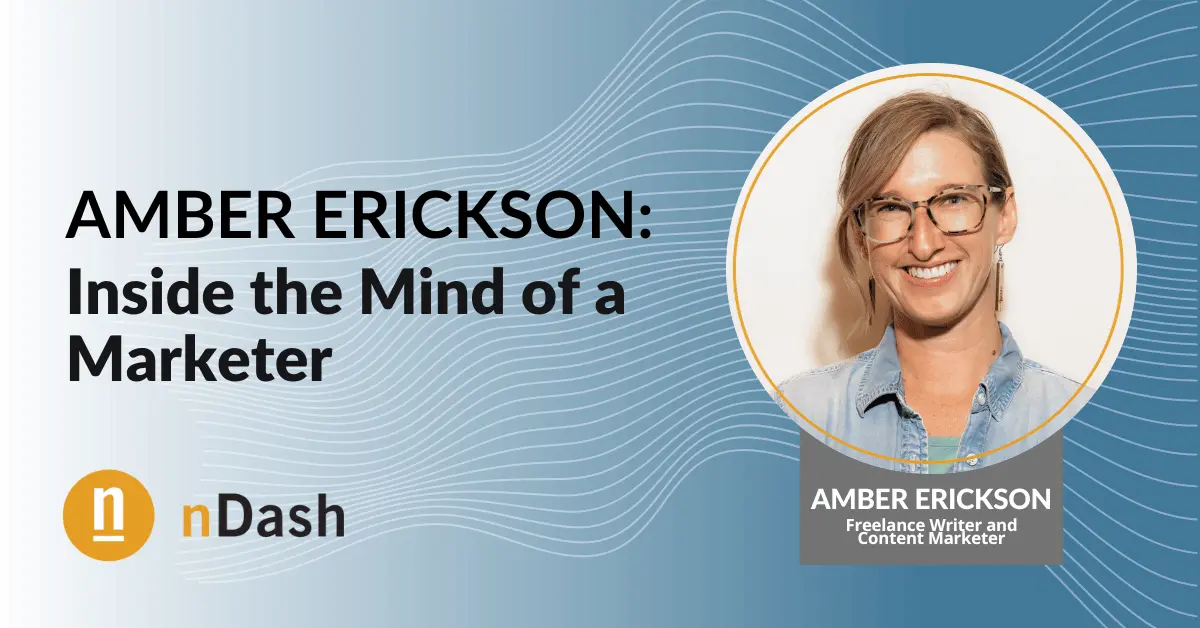We’re back with another marketer interview as part of our “Inside the Mind of a Marketer” series. This time, nDash’s Managing Editor, Jenn Greenleaf, talks to Amber Erickson about all things content creation and her experiences as a marketer.
Jenn: Thank you for taking the time to meet with me today! To begin – let’s talk about your journey in content marketing. How did it begin, and what attracted you to the field?
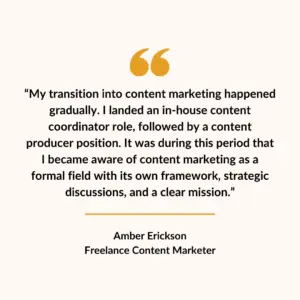 Amber: My journey in content marketing began somewhat unexpectedly. I have always been passionate about writing and reading. But I didn’t initially realize that content marketing was a path for me. I attended journalism school many years ago, where the options for writers were fairly limited – magazines, print media, and newspapers. Content marketing, as we now define it, wasn’t a thing.
Amber: My journey in content marketing began somewhat unexpectedly. I have always been passionate about writing and reading. But I didn’t initially realize that content marketing was a path for me. I attended journalism school many years ago, where the options for writers were fairly limited – magazines, print media, and newspapers. Content marketing, as we now define it, wasn’t a thing.
However, at that time, the online space was just beginning to emerge. Given my background in holistic health, it dawned on me that perhaps I could carve out a niche as a health writer. So, I began my journey as a freelance writer. I must admit it wasn’t a smooth ride initially; I faced my fair share of challenges and setbacks.
From there, my transition toward being a content marketer happened gradually. I landed an in-house content coordinator role, followed by a content producer position. During this period, I became aware of content marketing as a formal field with its framework, strategic discussions, and a clear mission. It was as if I had been doing content marketing all along without fully realizing it.
The turning point came when I became a content marketing manager at a Fortune 500 company. At the time, there wasn’t a structured content marketing program in place. It was more about fulfilling the marketing team’s content needs on demand. However, this experience made me realize the importance of having a strategy, a mission, and a purpose for our content. And I haven’t looked back.
Jenn: You’ve lived in both the agency (Epsilon) and in-house (Flowhub, Seed Technology) side of content. What do you see as the different challenges for each? If someone is considering both, how would you recommend they weigh the two to determine which would be a better fit for them?
Amber: I’ve had the opportunity to work in both agency and in-house roles in my career. But one unique experience at Epsilon that blurred the lines a bit. Even though part of the Epsilon business was technically an agency, I was on the marketing team tasked with marketing Epsilon’s services to other marketers. This role had an interesting mix of agency and in-house dynamics.
I found that in-house roles allowed me to go deeper into my work. I had the chance to truly understand the audience, be in their shoes, and hear from them regularly. My focus was almost entirely on our own company’s goals and strategies. This deep immersion can be incredibly rewarding if you thrive on understanding your audience inside out.
However, I also recognize the value of agency work, where you get exposure to various clients and industries. You can see how different companies approach their marketing, audiences, and strategies. It’s a fantastic learning experience, and you can gather a wealth of insights that can be applied to different contexts.
Regarding recommending which path to choose, it really depends on your goals and what suits you best. If you enjoy diving deep into a specific industry or company and want to become an expert in that niche, in-house roles might be more appealing. On the other hand, if you’re curious, adaptable, and thrive on variety, agency work can expose you to a diverse range of clients and challenges.
One important thing to remember is that in-house roles can sometimes lead to tunnel vision, where you’re so focused on your company that you might not pay as much attention to what’s happening in other industries. Agency work, while offering broader exposure, might not allow you to go as deep into a single niche.
Jenn: In your role at Seed Technology, you had a broad focus that included content, email, social, and more. How did you prioritize these channels, and how did you measure success?
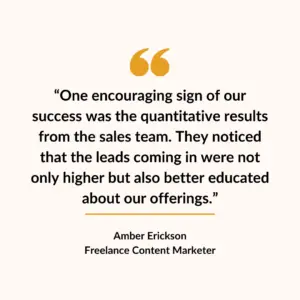 Amber: In my role as a marketer at Seed Technology, the initial challenges were prioritizing marketing channels like content, email, social media, and events. It wasn’t easy as there were budget constraints, and the company lacked a well-established marketing framework. I was the first marketing hire, so there was no precedent to follow.
Amber: In my role as a marketer at Seed Technology, the initial challenges were prioritizing marketing channels like content, email, social media, and events. It wasn’t easy as there were budget constraints, and the company lacked a well-established marketing framework. I was the first marketing hire, so there was no precedent to follow.
The main challenge was balancing short-term results with long-term potential. With limited budget resources, I often had to prioritize cheaper or free options, even if more expensive strategies had the potential for greater success. It was a constant juggling act, making decisions based on what I believed would benefit the company in the long run while still delivering short-term results.
Setting specific SMART goals was challenging for measuring success because our marketing efforts were essentially an experiment. Instead, I looked for an upward trajectory and focused on maintaining consistency. Even if site traffic didn’t experience a significant increase, I paid close attention to inbound leads and conversion rates as key indicators of success.
As strategies evolved, I adapted an approach based on the data we collected. We shifted our focus from simply increasing site traffic to improving conversion rates. This involved optimizing landing pages to attract the right audience and providing more value to visitors.
One encouraging sign of our success was the quantitative results from the sales team. They noticed that the leads coming in were not only higher but also better educated about our offerings. This indicated that our marketing efforts paid off in terms of lead quality, even if the channel-specific results were not always impressive.
Jenn: What were your favorite tools to use to measure those outcomes?
Amber: Well, when measuring outcomes, I’ve found that the choice of tools can vary. But what’s more important is the consistency in how you measure.
I’ve learned that the specific tool isn’t as crucial as using the same method consistently. Every analytics tool may offer slightly different insights, depending on filters or parameters. So, for me, the key is choosing a measurement approach. Then sticking to it consistently rather than being fixated on a particular tool.
Jenn: There’s a lot of uncertain regulation in the cannabis industry. As a marketer and writer, did you need to meet certain healthcare standards? If so, how did you monitor and ensure the quality of the content upheld these standards?
Amber: Being a marketer for the tech side of the industry indeed offered some advantages. However, this doesn’t mean we experienced fewer regulations. Often, most of the challenges arose around how dispensaries and tech brands could advertise—regulations concerning billboards, signage, and word usage, especially when addressing consumer audiences. Social media proved a critical yet careful ground. Accounts could be closed and ads denied, all of which were real concerns at Flowhub. We leaned heavily into content, mindful of our wording and imagery.
The newsletter served as a reliable channel to our opt-in audience. LinkedIn usually worked well, too. But with Instagram, there was always uncertainty regarding what would be accepted or removed. Every post was carefully considered—evaluating images and choosing words that would not imply selling. Posts about software and retail efficiencies were regularly flagged and removed, which was always baffling.
Some posts you’d expect to be taken down remained untouched, while others seemingly arbitrary were flagged. Having accounts closed was always a looming risk, making us extra cautious with our posts. LinkedIn appeared to be the most cannabis-friendly platform, with a booming professional community building there, which aligned well with our audience. We often discussed business topics, like hiring, retaining staff, laws, compliance, inventory, and auditing.
These discussions were generally less contentious; however, we still tread carefully due to the nuanced and specific laws and regulations. Disclaimers became a standard addition, reminding readers to check their state regulations and ensure the content’s applicability to them. We made an attempt to tailor content to each state’s specific laws, but it wasn’t always feasible or practical.
Jenn: As a marketer, was it a challenge to keep content consistent when you’re managing your teams?
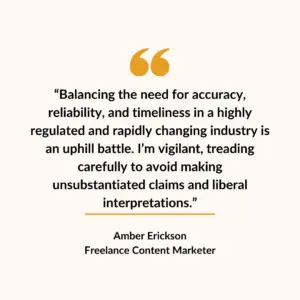 Amber: In my experience as a marketer and writer, it’s not just about consistency. Keeping the content updated and accurate poses even greater challenges. For example, if I’m writing an article about opening a dispensary in New York, I notice discrepancies in the comparables from articles that are just a few months old.
Amber: In my experience as a marketer and writer, it’s not just about consistency. Keeping the content updated and accurate poses even greater challenges. For example, if I’m writing an article about opening a dispensary in New York, I notice discrepancies in the comparables from articles that are just a few months old.
Regulations and laws are constantly being updated, and keeping content current is critical. Especially in the cannabis sector, many companies are startups with small teams struggling to post, publish, and maintain content regularly. While it would be ideal to update content every time a state releases a new regulation or clarity around laws emerges, the reality of achieving this is quite daunting. The ongoing maintenance to ensure the accuracy of the information seems nearly impossible due to the fast-paced changes in regulations and the limited resources available to most companies in this sector.
Dealing with information that’s nuanced and subject to interpretation adds another layer of complexity. Even when content is well written, incorporating legal perspectives, it’s often met with contradictions and debates over its accuracy and interpretation. A great example of this is my encounter with the billboard regulations in Michigan. Driving the interstate, dispensary billboards are a common sight. But reading the regs recently, I noticed they don’t allow billboards (unless you can prove that the majority of eyes on that sign are over 21). Contradictions and unclear rules like this make reporting on the law extremely challenging and risky.
Balancing the need for accuracy, reliability, and timeliness in a highly regulated and rapidly changing industry is an uphill battle. I’m vigilant, treading carefully to avoid making unsubstantiated claims and liberal interpretations. Working in such a regulated industry has made me acutely aware of the importance of cautiousness and precision in reporting and interpreting laws and regulations.
Jenn: Do you feel like, eventually, this industry is going to require some sort of quality check before they start publishing content?
Amber: Oh, that’s a good question! It’s common for cannabis businesses to employ professionals who specialize in compliance to ensure alignment with state laws and regulations. In tech companies, these compliance experts maintain relationships with government liaisons or representatives in their respective states, facilitating discussions about software development and interpreting various tracking requirements.
These compliance professionals are often key partners for marketing teams, contributing to marketing efforts. They clarify laws and possibly review content to ensure it complies with regulations, as was our practice at Flowhub.
However, the availability of such specialized individuals may vary, and some cannabis companies might not have immediate access to them. In such cases, leveraging available resources or incurring additional costs for legal reviews becomes essential, especially for law-specific projects. For instance, we enlisted cannabis-specific lawyers for a project focusing on essential retail-specific laws, much like health articles are often reviewed by an MD.
Legal reviews might not be necessary when dealing with non-compliance-related topics, such as employee retention, but inputs from relevant departments like HR can be valuable. In an age where expert and product-driven content is key, the content marketing industry must foster better practices, avoid working in silos, and regularly consult experts from varied domains to validate content.
Jenn: You’ve taught an Original Research Masterclass for Content Marketers. How important do you believe original research is in the world of content marketing, and what are some common mistakes you see when companies attempt to leverage it?
Amber: I believe that original research plays a crucial role in the world of content marketing. But my foray into original research was an accident. Over the years, I’ve been involved in various research projects, starting from scratch, where the idea was to extract insights from data and turn them into valuable content. One of my early experiences involved working with a database cooperative with a treasure trove of retail data. We decided to leverage this data for content, and it marked the beginning of my journey into original research.
I didn’t initially realize the significance of what I was doing. However, it became clear over time that original research offered a unique opportunity. It allowed us to say something genuinely distinctive, provide data that attracted backlinks and resulted in exceptional engagement and traction. Unlike regular blog posts, these research reports had a long-lasting impact and were continually referenced because nothing else came close to replacing them.
A few years ago, I recognized that original research was not only cool and fun but also incredibly effective in content marketing. I started thinking, “We need to do more of this.” Many software companies, for example, sit on vast piles of data that could be immensely insightful to their audience and industry. The main hurdle, however, was often the data collection and analysis part, especially for those who had never ventured into it.
To address this, I created a course to break down the process of original research for content marketing. The cohort-based live course provided tips, inspiration, and a step-by-step guide, essentially demystifying the entire process. We walk through the whole process together, where at the end of the week, students have a vetted topic, a project plan, and the start of their data collection process. It’s my way of telling people that they can do it.
Jenn: You’ve worked as a marketer and writer at both startups and established companies. How does the content strategy differ between the two, based on your experience?
Amber: That’s a hard question. In my experience as a marketer, the content strategy significantly differs between startups and established companies, and I’ve observed distinct variations in several aspects.
My experience as a marketer in established companies was that there wasn’t a standalone content strategy. In its place were strategies and tactics developed by other teams, who then needed content to serve that specific piece. It wasn’t that the content itself wasn’t strategic, but it wasn’t a holistic content plan.
On large teams, where everyone has their own goals and objectives, it can be challenging to operate a top-down content strategy, often feeling more like random acts of content than a strategic function. It also complicates execution due to more layers and processes. The pace was slower, and developing a coherent and cohesive strategy was challenging.
Contrastingly, in startups, content has a more prominent, strategic role. When a startup decides to hire for content, it implies a foundational belief in content as a key strategy. I found smaller, more collaborative teams facilitate more direct interaction with different functional areas, leading to a more cohesive and holistic approach to content strategy.
The speed of execution was notably faster, with more flexibility and adaptability in implementing and executing strategy, allowing the content team to own their strategies and have significant input in projects led by other functions.
Personally, I prefer the pace and energy of startups. I enjoy building content strategies, identifying processes, defining the voice, and executing on the overwhelming wealth of topics and content opportunities.
Jenn: Talk to us about AI in the content space – as a marketer and writer, where do you see it has value, and where does it fall short? How have you used it?
Amber: I use AI cautiously, aware of the ‘garbage in, garbage out’ principle. It’s a mental rule I follow. Not expecting every piece of information to be entirely accurate. AI is excellent for helping overcome the paralysis often faced with a blank page. It’s brilliant when I need a starting point, like drafting a blog outline or creating social posts from existing content.
I’m a faster editor than a writer. Having a base to work from allows me to rearrange, highlight, and refine content more efficiently. AI provides that messy page, enabling me to react and reorganize rather than create from scratch. It doesn’t necessarily reduce my workload or time; it just changes the process for me.
But I think it does help elevate the quality as well because I can ask things like, what am I missing? Or, what’s another way to say this, or what’s a synonym for this word? So, those kinds of specific use cases help elevate the thoroughness and value of my work.
I wouldn’t rely on AI to write a complete blog post, as it often produces generic content that lacks depth and interest. However, it’s handy for generating topic ideas, suggesting headings, and recommending additional keywords. It guides me through the page creation process more effortlessly than the old-school way.
Jenn: What are you currently working on? What challenges are you hoping to tackle next?
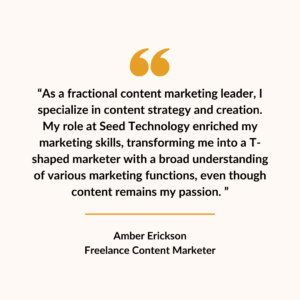 Amber: Well, after being laid off from my role at Seed last spring, I was working on a contractual basis and deciding what to do with my life. I recently opted to join the freelance movement full-time. I’d been weighing the pros and cons of staying on contract vs. going back in-house. I was trying to determine which path suited me best and which opportunity presented itself first.
Amber: Well, after being laid off from my role at Seed last spring, I was working on a contractual basis and deciding what to do with my life. I recently opted to join the freelance movement full-time. I’d been weighing the pros and cons of staying on contract vs. going back in-house. I was trying to determine which path suited me best and which opportunity presented itself first.
Going freelance became an obvious choice. That’s mainly because I already had a decent roster of consistent work. And with a decade of content marketing experience, I had contacts and a network to draw from. It felt not only safe but like I could build the work life I dreamed of.
As a fractional content marketing leader, I specialize in content strategy and creation. My role at Seed Technology enriched my marketing skills, transforming me into a T-shaped marketer with a broad understanding of various marketing functions, even though content remains my passion. For clients, I do everything from running strategy and editorial plans to writing articles.
Jenn: Is there anything else you’d like our readers to know about being a freelance writer or content marketer?
Amber: The main thing I’m noticing is a shift towards freelance writing careers, with many people aspiring to earn a living from writing. Despite their struggle, possibly due to limited work, layoffs, or AI, opportunities are still available in this space.
Great writers with well-rounded skills, including SEO knowledge and strategic thinking, will continue to find work opportunities. The freelance lifestyle can be attainable and rewarding for those willing to invest the initial effort to establish themselves.
Many companies favor the flexibility of hiring specialists on a fractional basis instead of full-time. They’re finding value in turning to experienced specialists for specific roles, like social media management, at a fraction of the cost of a full-time employee. This approach will likely become the norm for many marketing teams, providing sustained opportunities for self-employed writers to engage in varied and meaningful work.
About Amber Erickson:
 Amber Erickson is a distinguished content marketer with over a dozen years of progressive experience specializing in creating unique, actionable, and memorable B2B content. Valuing original research, Amber has conducted numerous research projects utilizing surveys, third-party data, and first-party SaaS data to resonate with target audiences. Besides her professional endeavors, Amber is passionate about traveling, cycling, and exploring nature in Michigan’s upper peninsula.
Amber Erickson is a distinguished content marketer with over a dozen years of progressive experience specializing in creating unique, actionable, and memorable B2B content. Valuing original research, Amber has conducted numerous research projects utilizing surveys, third-party data, and first-party SaaS data to resonate with target audiences. Besides her professional endeavors, Amber is passionate about traveling, cycling, and exploring nature in Michigan’s upper peninsula.
